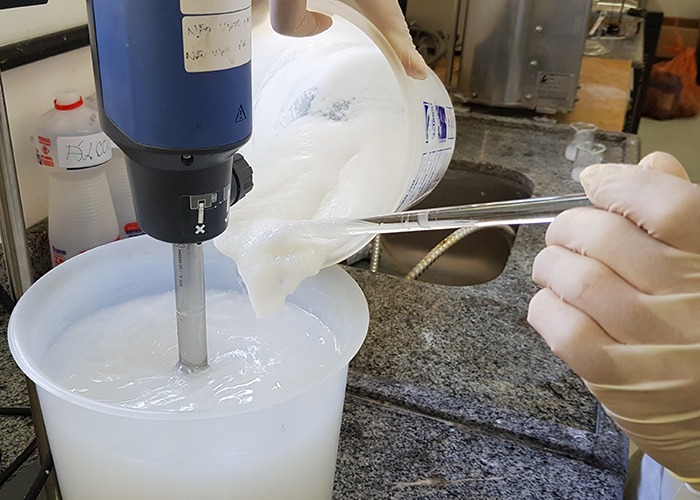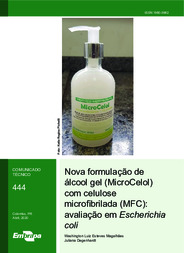Scientists obtain a thickening agent from pine and eucalyptus cellulose to produce alcohol hand sanitizer
Scientists obtain a thickening agent from pine and eucalyptus cellulose to produce alcohol hand sanitizer
Photo: Kátia Pichelli

Microfibrillated cellulose (MFC) derived from pine and eucalyptus is an effective thickening agent and emulsifier in the production of antiseptic alcohol
|
Researchers from Embrapa Forestry have shown that microfibrillated cellulose (MFC) from pine and eucalyptus is an effective thickening agent and emulsifier in the production of antiseptic alcohol and alcohol hand sanitizer, products used in the front lines against coronavirus infections which are in great consumer demand.
According to the Brazilian Association of the Personal Hygiene Products, Perfume, and Cosmetics Industry (ABIHPEC), due to the coronavirus pandemic, global demand for alcohol-based hand sanitizing gel has grown ten times in comparison with 2019. This has caused a shortage of carbopol, a carbomer that is the most common thickening agent used to manufacture such product. As a result, the Brazilian Health Regulatory Agency (ANVISA) has eased standards for the production of alcohol hand sanitizer, and several institutions have worked together to produce and deliver the product.
The Wood Technology Laboratory at Embrapa Forestry tested different formulations to produce 70% alcohol gel, using nanocellulose from pine and eucalyptus as a thickening agent instead of carbopol. Bleached cellulose pulp undergoes a process of mechanical defibrillation, which produces an aqueous nanocellulose dispersion with the properties of a gel that can replace carbopol in the emulsification process. "We started with bleached pine pulp because it creates a more viscous nanocellulose suspension than eucalyptus. But then we tested eucalyptus pulp and adapted the formulations," explains Embrapa researcher Washington Magalhães (click here for more information - file in Portuguese).
The microfibrillated cellulose was produced in cooperation with the department of research and development at Klabin, which has a test plant to produce MFC that can reach suitable pulp defibrillation levels to produce hand sanitizer. "This team is focused on developing new products and processes," says Carlos Augusto Santos, corporate manager for research, development, and innovation at Klabin.
Product being used by border inspectors
At the first stage, 100 liters of 70% alcohol sanitizer were sent to the health surveillance section of the Ministry of Agriculture, Livestock and Food Supply (MAPA), especially for use at inspection posts on the borders with the states of Paraná and Santa Catarina.
"Our team has already tested the formulation for effectiveness, and we are confident of its quality, since all the ingredients are included in the Brazilian Pharmacopoeia," explains Magalhães. He adds that the alcohol used is 92.8° GL, obtained from traditional manufacturers, and that the work consisted in transforming it into a 70% alcohol sanitizing gel.
At the same time, the are cointinuing efforts on other formulations to produce alcohol hand sanitizer using different types of nanocellulose. "This partnership with Klabin will increase our production and distribution capacity during this pandemic, and also strengthen technical knowledge-sharing between the teams," says Magalhães. "It is being done on a small scale because our laboratory facilities are not set up for large-scale production."
Work on refining the Embrapa network
For this purpose, MFC will be distributed to Embrapa’s other units across Brazil with directions so that each unit can mix up the hand sanitizer and use it in daily activities. One advantage of this process is that the exchange will allow other laboratories to experiment and suggest improvements.
Because it is still being used experimentally, distribution of this product will be limited and controlled according to safety standards and protocols. "We believe that speed is important at this time, but we need to be safe," adds Magalhães.
The nanocellulose used in this research comes from bleached cellulose pulp, which is also a raw material used to manufacture products such as paper, corrugated cardboard, and disposable diapers. "This is another use for raw materials from planted forests," says Magalhães. "These products are present in our everyday lives, and most people have no idea that they come from renewable and sustainable forest plantations”.
MFC
MFC is a byproduct of the process used to develop cellulose nanostructure. Nanostructured cellulose can be obtained in several ways: through chemical processes such as controlled acid hydrolysis, which produces cellulose nanocrystals (CNC), or mechanical processes to defibrillate the cellulose. Mechanical processes may take place either after or at the same time as chemical treatments that create nanofibrillated cellulose (NFC); moreover, they may utilize only water and no chemical reagents to create microfibrillated cellulose (MFC), which is being used in this experimental process by Embrapa.
A versatile material with various uses
Nanocellulose has potential for use in various sectors such as cosmetics, pharmaceuticals, and foodstuffs; it controls viscosity and stabilizes oil emulsions. In the food sector, it is used in edible films and packaging. In Japan, some pens contain ink made with NFC. It can also be used to make membranes for wound dressing or for ultra- and nano-filtration, or as an additive in cement, among other applications. But its most frequent use may be to reinforce cardboard and paperboard in pulp and paper plants.
Agribusiness is the second-largest market for MFC, with the development of slow-release fertilizers and agrochemicals, and this product is also used as an anti-drift agent and as coating for fruit.
Photo: Kátia Pichelli
Translation: Outsourced, edited by Mariana Medeiros.
Katia Pichelli (MTb 3594/PR)
Embrapa Forestry
Press inquiries
florestas.imprensa@embrapa.br
Phone number: +55 41 99977-5787
Further information on the topic
Citizen Attention Service (SAC)
www.embrapa.br/contact-us/sac/

